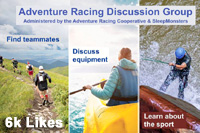Réunion d’Aventures
Craters and Cirques
Rob / 16.09.2003


They would start on the less populated East coast, on the other side of the island, with a run/roller blading stage from near the fishing port of St. Benoit, setting off through sugar cane plantations southwards towards the volcanic area of the island. The solidified black volcanic lava flows sweep down right to the coast here and the ocean swells break fiercely onto the abrasive rocks where the lava hit the sea. This is the setting for some demanding coasteering, followed by more roller blading. The road they are following has often been swept away and patiently rebuilt, and they will follow it for 50kms before the trek up Piton de la Fournaise begins. (Everyone just calls it The Volcano.)
The route climbs along the Tremblant ridge, through 2000m of humid jungle, which gradually thins with altitude until they emerge into the vast moonscape of the volancoes upper slopes. From the the viewpoint of Pas de Bellcombe, where the tourist coaches disgorge after a tortuous journey, they drop 300m into the main crater, to cross it and climb the summit cone. It does not look far but the scale is very deceptive and if the afternoon clouds roll in, as they usually do, they’ll need their compasses as there are no features in the crater, just bare, burned rock.
Back as Pas de Bellcombe it’s time to switch to mountain bikes, but probably only after a night’s rest. A feature of Reunion d’Aventures is that teams must stop at 6.00 pm each night as darkness falls, and bivouac out. The philospophy behind this race is entirely different to race Director Gerard Fusil’s earlier, multi-day epics, the Raid Gauloises and Elf Authenique Adventure.
Now he believes racing non-stop means exhausted competitors don’t enjoy the scenery and their experiences to the full, and that extreme fatigue could be dangerous. So this new race is a stage race, where teams must still look after themselves, but have to plan carefully to find a good campsite each night. On the Volcano the problems will be water supply, and at 2300m, the cold, even on this tropical island.
The morning descent down into the Plein des Caffres will be fast and furious, and is followed by a chance to cool off in a canyon descent before the trek up peak of Dimitile and on to the top of the island, the summit of Piton des Neiges at 3069m. From here they can see the three mighty cirques spread out around them, Cilaos, Mafate and Salazie. Only the leading teams are likely to make the climb though, slower teams will take the shorter, ‘adventure course’, directly down into Cirque Cilaos to start the descent of the stunning Canyon de Fleur Jaune and then continue directly to the peak of Maido.







 SleepMonsters
SleepMonsters



